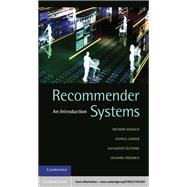
Note: Supplemental materials are not guaranteed with Rental or Used book purchases.
Purchase Benefits
What is included with this book?
| Foreword | p. ix |
| Preface | p. xiii |
| Introduction | p. 1 |
| Part I: Introduction to basic concepts | p. 2 |
| Part II: Recent developments | p. 8 |
| Introduction to Basic Concepts | |
| Collaborative recommendation | p. 13 |
| User-based nearest neighbor recommendation | p. 13 |
| Item-based nearest neighbor recommendation | p. 18 |
| About ratings | p. 22 |
| Further model-based and preprocessing-based approaches | p. 26 |
| Recent practical approaches and systems | p. 40 |
| Discussion and summary | p. 47 |
| Bibliographical notes | p. 49 |
| Content-based recommendation | p. 51 |
| Content representation and content similarity | p. 52 |
| Similarity-based retrieval | p. 58 |
| Other text classification methods | p. 63 |
| Discussion | p. 74 |
| Summary | p. 77 |
| Bibliographical notes | p. 79 |
| Knowledge-based recommendation | p. 81 |
| Introduction | p. 81 |
| Knowledge representation and reasoning | p. 82 |
| Interacting with constraint-based recommenders | p. 87 |
| Interacting with case-based recommenders | p. 101 |
| Example applications | p. 113 |
| Bibliographical notes | p. 122 |
| Hybrid recommendation approaches | p. 124 |
| Opportunities for hybridization | p. 125 |
| Monolithic hybridization design | p. 129 |
| Parallelized hybridization design | p. 134 |
| Pipelined hybridization design | p. 138 |
| Discussion and summary | p. 141 |
| Bibliographical notes | p. 142 |
| Explanations in recommender systems | p. 143 |
| Introduction | p. 143 |
| Explanations in constraint-based recommenders | p. 147 |
| Explanations in case-based recommenders | p. 157 |
| Explanations in collaborative filtering recommenders | p. 161 |
| Summary | p. 165 |
| Evaluating recommender systems | p. 166 |
| Introduction | p. 166 |
| General properties of evaluation research | p. 167 |
| Popular evaluation designs | p. 175 |
| Evaluation on historical datasets | p. 177 |
| Alternate evaluation designs | p. 184 |
| Summary | p. 187 |
| Bibliographical notes | p. 188 |
| Case study: Personalized game recommendations on the mobile Internet | p. 189 |
| Application and personalization overview | p. 191 |
| Algorithms and ratings | p. 193 |
| Evaluation | p. 194 |
| Summary and conclusions | p. 206 |
| Recent Developments | |
| Attacks on collaborative recommender systems | p. 211 |
| A first example | p. 212 |
| Attack dimensions | p. 213 |
| Attack types | p. 214 |
| Evaluation of effectiveness and countermeasures | p. 219 |
| Countermeasures | p. 221 |
| Privacy aspects - distributed collaborative filtering | p. 225 |
| Discussion | p. 232 |
| Online consumer decision making | p. 234 |
| Introduction | p. 234 |
| Context effects | p. 236 |
| Primacy/recency effects | p. 240 |
| Further effects | p. 243 |
| Personality and social psychology | p. 245 |
| Bibliographical notes | p. 252 |
| Recommender systems and the next-generation web | p. 253 |
| Trust-aware recommender systems | p. 254 |
| Folksonomies and more | p. 262 |
| Ontological filtering | p. 279 |
| Extracting semantics from the web | p. 285 |
| Summary | p. 288 |
| Recommendations in ubiquitous environments | p. 289 |
| Introduction | p. 289 |
| Context-aware recommendation | p. 291 |
| Application domains | p. 294 |
| Summary | p. 297 |
| Summary and outlook | p. 299 |
| Summary | p. 299 |
| Outlook | p. 300 |
| Bibliography | p. 305 |
| Index | p. 333 |
| Table of Contents provided by Ingram. All Rights Reserved. |
The New copy of this book will include any supplemental materials advertised. Please check the title of the book to determine if it should include any access cards, study guides, lab manuals, CDs, etc.
The Used, Rental and eBook copies of this book are not guaranteed to include any supplemental materials. Typically, only the book itself is included. This is true even if the title states it includes any access cards, study guides, lab manuals, CDs, etc.